External links
| General | |
|---|---|
| National libraries | |
| | This article about an organisation based in Germany is a stub. You can help Wikipedia by expanding it. |
The Landsmannschaft der Banater Schwaben e.V. ("Territorial Association of Banat Swabians", "Homeland Association of Banat Swabians") is an organization of German Banat Swabians refugees expelled from their homes in Banat, Romania after World War II.
The organization is based in Munich, and it was founded in 1950.

Freidorf was one of the first German settlements in Temes County in the Banat, Kingdom of Hungary. In 1920, it became part of Romania; since 1950 it is a district of the city of Timișoara. Freidorf maintains historic architecture, old Banat Swabian houses, and many green spaces.

The Transylvanian Saxons are a people of German ethnicity who were settled in Transylvania in waves starting from the mid-12th century until the late modern period.

The Danube Swabians is a collective term for the ethnic German-speaking population who lived in various countries of southeastern Europe, especially in the Danube River valley, first in the 12th century, and in greater numbers in the 17th and 18th centuries. Most were descended from earlier 18th-century Swabian settlers from Upper Swabia, northern Lake Constance, upper Danube, Southern Black Forest and Principality of Fürstenberg, followed by Hessian, Bavarians, Franks and Lothrigians recruited by Austria to repopulate the area and restore agriculture after the expulsion of the Ottoman Empire. They were able to keep their language and religion and initially developed strongly German communities in the region.
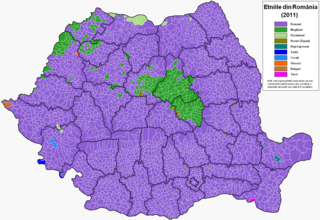
About 10.5% of Romania's population is represented by minorities. The principal minorities in Romania are Hungarians and Romani people, with a declining German population and smaller numbers of Poles in Bukovina, Serbs, Croats, Slovaks and Banat Bulgarians, Ukrainians, Greeks, Jews, Turks and Tatars, Armenians, Russians, Afro-Romanians, and others.

The Germans of Romania represent one of the most significant ethnic minorities of Romania. During the interwar period, the total number of ethnic Germans in this country amounted to as much as c. 800,000, a figure which has subsequently fallen to c. 36,000.

Knićanin is a village in Serbia. It is located in the Zrenjanin municipal area, in the Banat region, Vojvodina province. Its population is 2,034 and most of its inhabitants are ethnic Serbs (97.39%).
The Banat Swabians are an ethnic German population in Central-Southeast Europe, part of the Danube Swabians. They emigrated in the 18th century to what was then the Austrian Empire's Banat of Temeswar province, later included in the Habsburg Kingdom of Hungary, a province which had been left sparsely populated by the wars with Turkey. At the end of World War I in 1918, the Swabian minority worked to establish an independent multi-ethnic Banat Republic; however, the province was divided by the Treaty of Versailles of 1919, and the Treaty of Trianon of 1920. The greater part was annexed by Romania, a smaller part by the Kingdom of Serbs, Croats and Slovenes and a small region around Szeged remained part of Hungary.

The Banat was a political entity established in 1941 after the occupation and partition of Yugoslavia by the Axis Powers in the historical Banat region. It was formally under the control of the German puppet Government of National Salvation in Belgrade, which theoretically had limited jurisdiction over all of the Territory of the Military Commander in Serbia, but all power within the Banat was in the hands of the local minority of ethnic Germans (Volksdeutsche). The regional civilian commissioner and head of the ethnic German minority was Josef Lapp. Following the ousting of Axis forces in 1944, this German-ruled region was dissolved and most of its territory was included into Vojvodina, one of the two autonomous provinces of Serbia within the new SFR Yugoslavia.
German Hungarians are the German-speaking minority of Hungary, sometimes called Danube Swabians, many of whom call themselves "Shwoveh". There are 131,951 German speakers in Hungary. Danube Swabian is a collective term for a number of German ethnic groups who lived in the former Kingdom of Hungary, including the Kingdom of Croatia-Slavonia and Vojvodina.
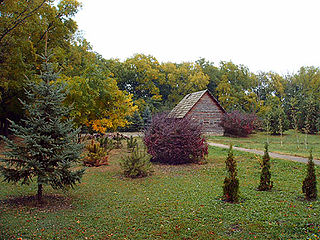
Banatsko Veliko Selo is a village located in the municipality of Kikinda, North Banat District, Serbia. It is situated in the Autonomous Province of Vojvodina. The village has a population of 3,034, of which the majority are Serbs (96.30%).
The Germans of Yugoslavia are people of German descent who live in Croatia, Serbia, Bosnia and Herzegovina, or Slovenia. The Germans of the former Yugoslavia include both Danube Swabians and Austrians. The largest German minority in the former Yugoslavia is in Serbia.
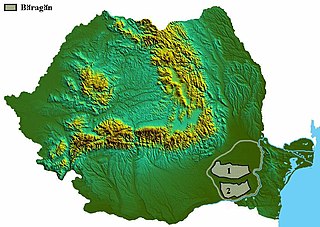
The Bărăgan deportations were a large-scale action of penal transportation, undertaken during the 1950s by the Romanian Communist regime. Their aim was to forcibly relocate individuals who lived within approximately 25 km of the Yugoslav border to the Bărăgan Plain. The deportees were allowed to return after 1956.

Banatski Despotovac is a village in Serbia. It is located in the municipal area of the City of Zrenjanin, in the Central Banat District, Vojvodina province. The village has a Serb ethnic majority (98.2%) and its population numbers 1,620 people.
The presence of German-speaking populations in Central and Eastern Europe is rooted in centuries of history, with the settling in northeastern Europe of Germanic peoples predating even the founding of the Roman Empire. The presence of independent German states in the region, and later the German Empire as well as other multi-ethnic countries with German-speaking minorities, such as Hungary, Poland, Imperial Russia, etc., demonstrates the extent and duration of German-speaking settlements.

Stefan Jäger was a painter known for his depiction of and deep identification with the Danube Swabian community to which he belonged.

Dudeștii Noi is a commune in Timiș County, Romania. It is composed of a single village, Dudeștii Noi, part of the commune of Becicherecu Mic until 2004, when it was split off.
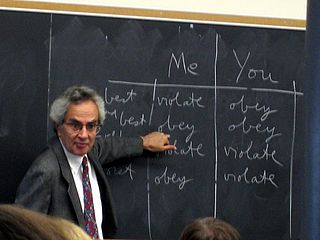
The Germans of Serbia are an ethnic minority of Serbia which numbers 4,064 people according to last population census from 2011. The Germans of Serbia usually refer to themselves as Swabian, and they are grouped into the Danube Swabians or Banat Swabians in the Vojvodina region, where the majority of the population resides. Germans settled parts of Serbia in the late 17th century during Habsburg administration. The German population of Vojvodina was more numerous in the past.
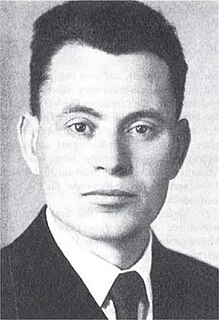
Josef "Sepp" Janko was a Volksgruppenführer of the Danube Swabian German Cultural Association in Yugoslavia in 1939, and later was appointed SS Obersturmführer during World War II.

The deportation of Germans from Romania after World War II, conducted on Soviet order early in 1945, uprooted 60,000 to 75,000 of Romania's Germans to the USSR; at least 3,000 of the deportees died before release. The deportation was part of the Soviet plan for German war reparations in the form of forced labor, according to the 1944 secret Soviet Order 7161. Most of the survivors returned to Romania between late 1945 and 1952, with a smaller part settling in different parts of Germany.

Count, Karl von Möller AOL O was an officer, journalist, author and politician from Banat. He was an enthusiastic supporter of Hitler's National Socialism. In 1932, he published the antisemitic newspaper "Der Stürmer" in Timișoara, an imitation of the German Nazi publication. He was married to Margaret Jung, with whom he had two children.